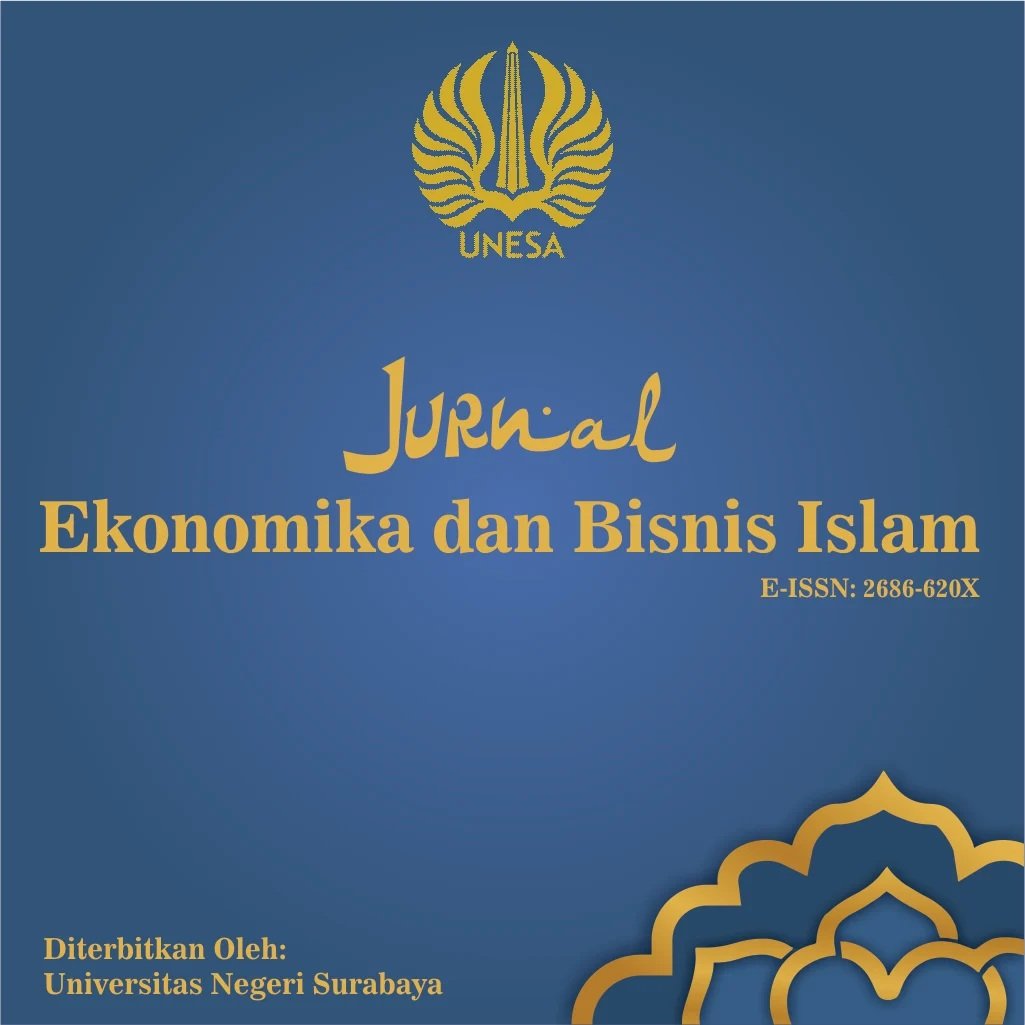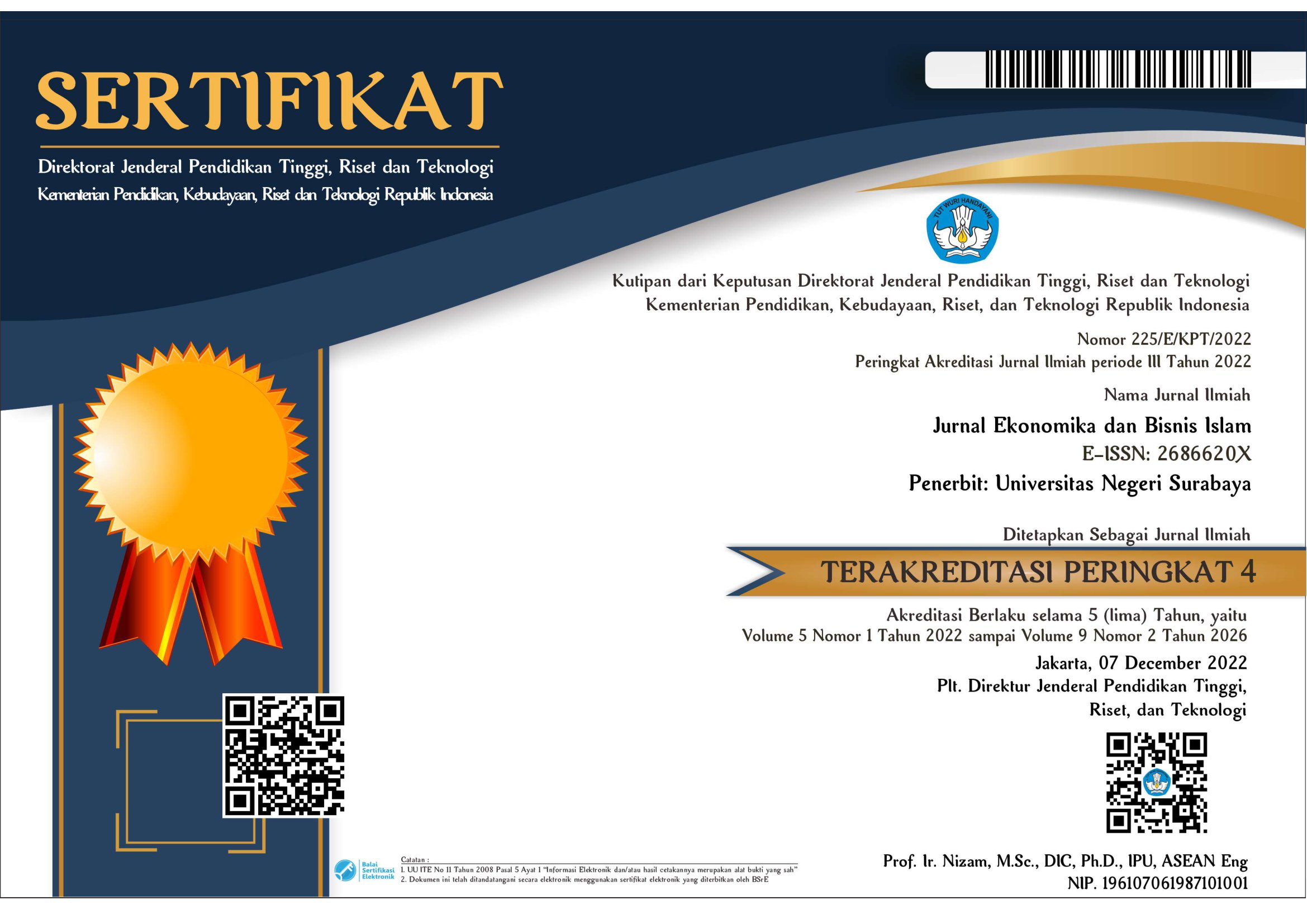Pengaruh Non-Performing Financing, Dana Pihak Ketiga, Dan Likuiditas Terhadap Profitabilitas Bank Syariah Di Indonesia
DOI:
https://doi.org/10.26740/jekobi.v8n1.p141-152Kata Kunci:
Bank Syariah, Non-Performing Financing, Dana Pihak Ketiga, Likuiditas, ProfitabilitasAbstrak
Penelitian ini bertujuan untuk melihat pengaruh Non-Performing Financing, Dana Pihak Ketiga, dan likuiditas terhadap profitabilitas bank syariah di Indonesia. Non-Performing Financing direpresentasikan oleh rasio Non-Performing Financing dan likuiditas direpresentasikan oleh rasio Short-Term Mistmach. Profitabilitas direpresentasikan oleh rasio Return on Asset. Metode yang digunakan dalam penelitian ini adalah metode penelitian kuantitatif. Data yang digunakan dalam penelitian ini adalah data sekunder Statistik Perbankan Syariah yang dipublikasi oleh OJK. Periode penelitian yang digunakan dari triwulan I 2015 sampai triwulan IV 2023. Analisis yang digunakan adalah analisis regresi linear berganda menggunakan aplikasi Eviews 13. Hasil penelitian ini memperlihatkan bahwa DPK berpengaruh signifikan terhadap profitabilitas bank syariah. Sedangkan NPF dan likuiditas tidak berpengaruh signifikan terhadap profitabilitas bank syariah.
Referensi
Almunawwaroh, M., & Marliana, R. (2018). Pengaruh Car,Npf Dan Fdr Terhadap Profitabilitas Bank Syariah Di Indonesia. Amwaluna: Jurnal Ekonomi Dan Keuangan Syariah, 2(1), 1–17. https://doi.org/10.29313/amwaluna.v2i1.3156
Amin, D. S., Bakri, M. I., & Jurana. (2023). Pengaruh Kinerja Keuangan Terhadap Nilai Perusahaan Dengan Pengungkapan Corporate Social Responsibility Sebagai Variabel Moderating. Jurnal Ekonomi Kreatif Indonesia, 1(3), 198–211. https://doi.org/10.61896/jeki.v1i3.14
Amri, H., & Nuraha, R. (2021). Pengaruh Likuiditas terhadap profitabilitas pada PT Bank Syariah Mandiri Periode 2016-2020. Jurnal Ekonomi Syari’ah, 5(2), 1–13.
Ayu, D., Afifah, N., Guntur, &, & Wardana, K. (2022). Pengaruh Likuiditas, Efektivitas, Dan Pembiayaan Bagi Hasil Terhadap Profitabilitas Perbankan Syariah Di Indonesia. Jurnal Tabarru’ : Islamic Banking and Finance, 5(1).
Bisma, reindra prasista, & Hadi, effed darta. (2024). Reslaj : Religion Education Social Laa Roiba Journal Sarjanawiyata Tamansiswa Reslaj : Religion Education Social Laa Roiba Journal. Reslaj : Religion Education Social Laa Roiba Journal, 5(1), 168–184. https://doi.org/10.47476/reslaj.v6i4.1960
Hana, K. F., Aini, M., & Putri Karsono, L. D. (2022). Pandemi Covid 19: Bagaimana Kondisi Likuiditas Bank Syariah di Indonesia? Al Maal: Journal of Islamic Economics and Banking, 4(1), 16. https://doi.org/10.31000/almaal.v4i1.5840
Hananto, B. (2022). Kinerja Perbankan Syariah di Indonesia Masa Pandemi Covid19. Jurnal Ekonomi Syariah Pelita Bangsa, 7(01), 82–92. https://doi.org/10.37366/jespb.v7i01.380
Hendriawan, W., Siregar, E. S., & Martaliah, N. (2024). Pengaruh Dana Pihak Ketiga, Financing to Deposit Ratio dan Non Performing Finacing Terhadap Pembiayaan Murabahah Pada Bank Umum Syariah di Indonesia Tahun 2018-2022. Jurnal Kajian Dan Penalaran Ilmu Manajemen, 2(1), 216–230.
Khasanah, U., Qurrota A’yun, I., Afandi, M. A., Maestri, S. S., Dahlan, A., & Metro, U. M. (2022). Analisis Pengaruh Car, Npf, Fdr, Dan Bopo Terhadap Profitabilitas Bank Umum Syariah Di Indonesia. Derivatif : Jurnal Manajemen, 16(2).
Mawaddah, N. (2015). Faktor-Faktor Yang Mempengaruhi Profitabilitas Bank Syariah. Etikonomi, 14(2). https://doi.org/10.15408/etk.v14i2.2273
Mulyono, T. P. (1999). Analisa laporan keuangan untuk perbankan / disusun oleh Teguh Pujo Mulyono. Jakarta : Djambatan, 1999.
Nugraheni, P., & Alam, W. F. I. (2014). Pengaruh Risiko Likuiditas terhadap Profitabilitas pada Perbankan Syariah dan Konvensional di Indonesia. Islamiconomic: Jurnal Ekonomi Islam, 15(1), 1–16.
Rahman, A. F., & Rochmanika, R. (2023). Pengaruh Pembiayaan Jual Beli, Pembiayaan Bagi Hasil, dan Nonperforming Financing terhadap Profitabilitas Bank Umum Syariah di Indonesia. Jurnal Alwatzikhoebillah : Kajian Islam, Pendidikan, Ekonomi, Humaniora, 9(2), 376–384. https://doi.org/10.37567/alwatzikhoebillah.v9i2.1839
Risfiati, I., & Utama, H. B. (2019). Pengaruh Dana Pihak Ketiga, Capital Adequacy Ratio, Non Performing Financing, Dan Return on Asset Terhadap Penyaluran Pembiayaan Pada Bank Umum Syariah Di Indonesia Periode 2015-2017. Jurnal Aktual, 4(1), 83–92.
Sarmigi, E. (2021). Pengaruh Dana Pihak Ketiga Dan Pertumbuhan Pembiayaan Terhadap Profitabilitas Bank Umum Syariah Periode 2015-2019. AL-Fiddoh, 2(2).
Siamat, D. (2005). Manajemen Lembaga Keuangan: Kebijakan Moneter dan Perbankan (5th ed.). Lembaga Penerbit Fakultas Ekonomi Universitas Indonesia.
Solihatun, . (2014). Analisis Non Performing Financing (Npf) Bank Umum Syariah Di Indonesia Tahun 2007 – 2012. Jurnal Ekonomi Pembangunan, 12(1), 58. https://doi.org/10.22219/jep.v12i1.3655
Sudarsono, H., Rubha, S. M., & Rudatin, A. (2018). Pengaruh likuiditas terhadap profitabilitas di bank syariah. Conference on Islamic Management Accounting and Economics, 1, 147–152.
Undang-undang (UU) Nomor 21 Tahun 2008 tentang Perbankan Syariah (Vol. 3, Issue 2, pp. 54–67). (2008).
Wiroso. (2005). Penghimpunan dana dan distribusi hasil usaha Bank Syariah. Jakarta : Grasindo.
Unduhan
Diterbitkan
Cara Mengutip
Terbitan
Bagian
Lisensi
Hak Cipta (c) 2025 Muhammad Rizki Zakaria, Andriawan Yoga, Inayati Nuraini Dwiputri

Artikel ini berlisensi Creative Commons Attribution 4.0 International License.
This work is licensed under a Creative Commons Attribution 4.0 International License.
 Abstract views: 190
,
Abstract views: 190
, PDF Downloads: 165
PDF Downloads: 165














